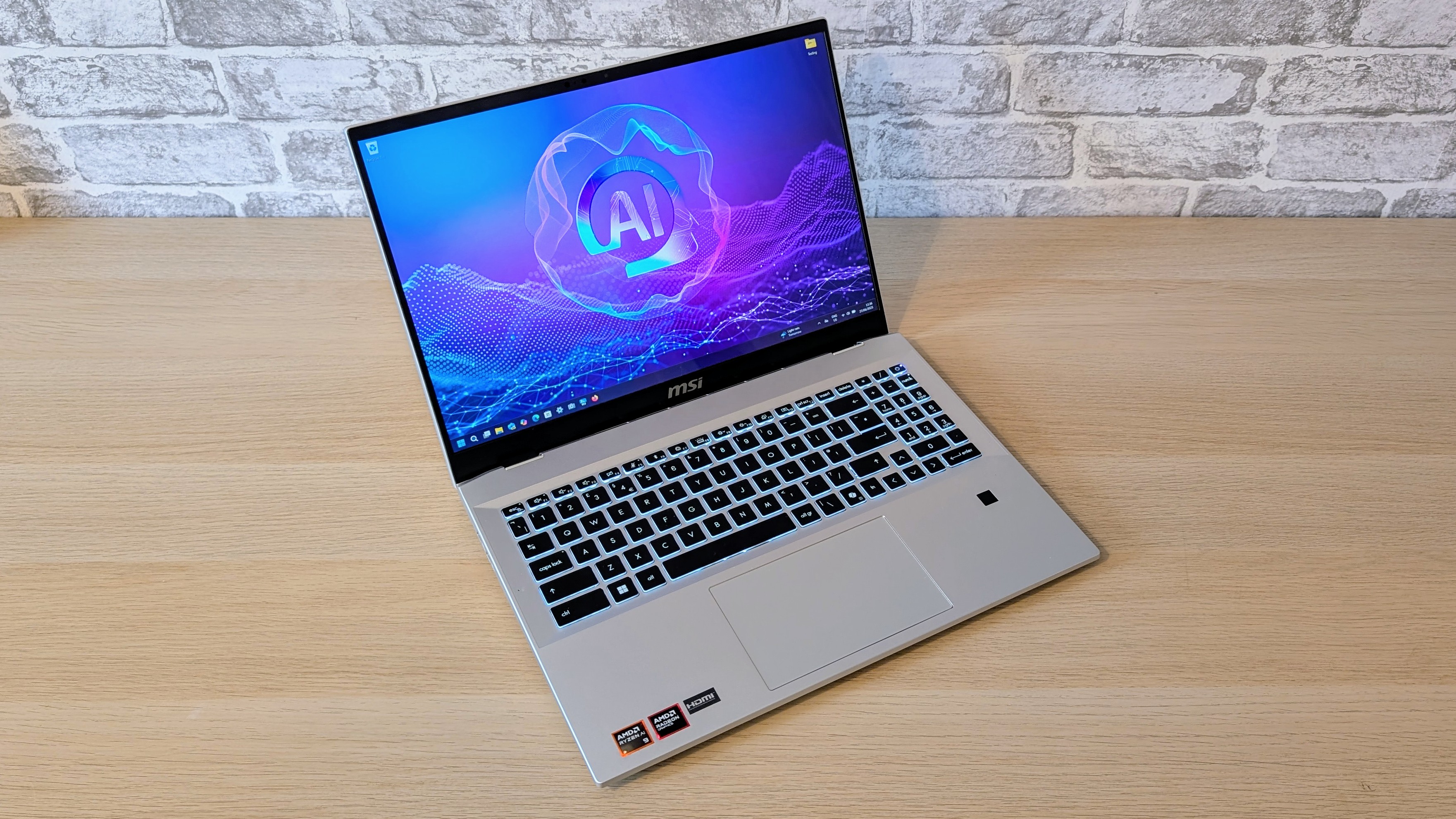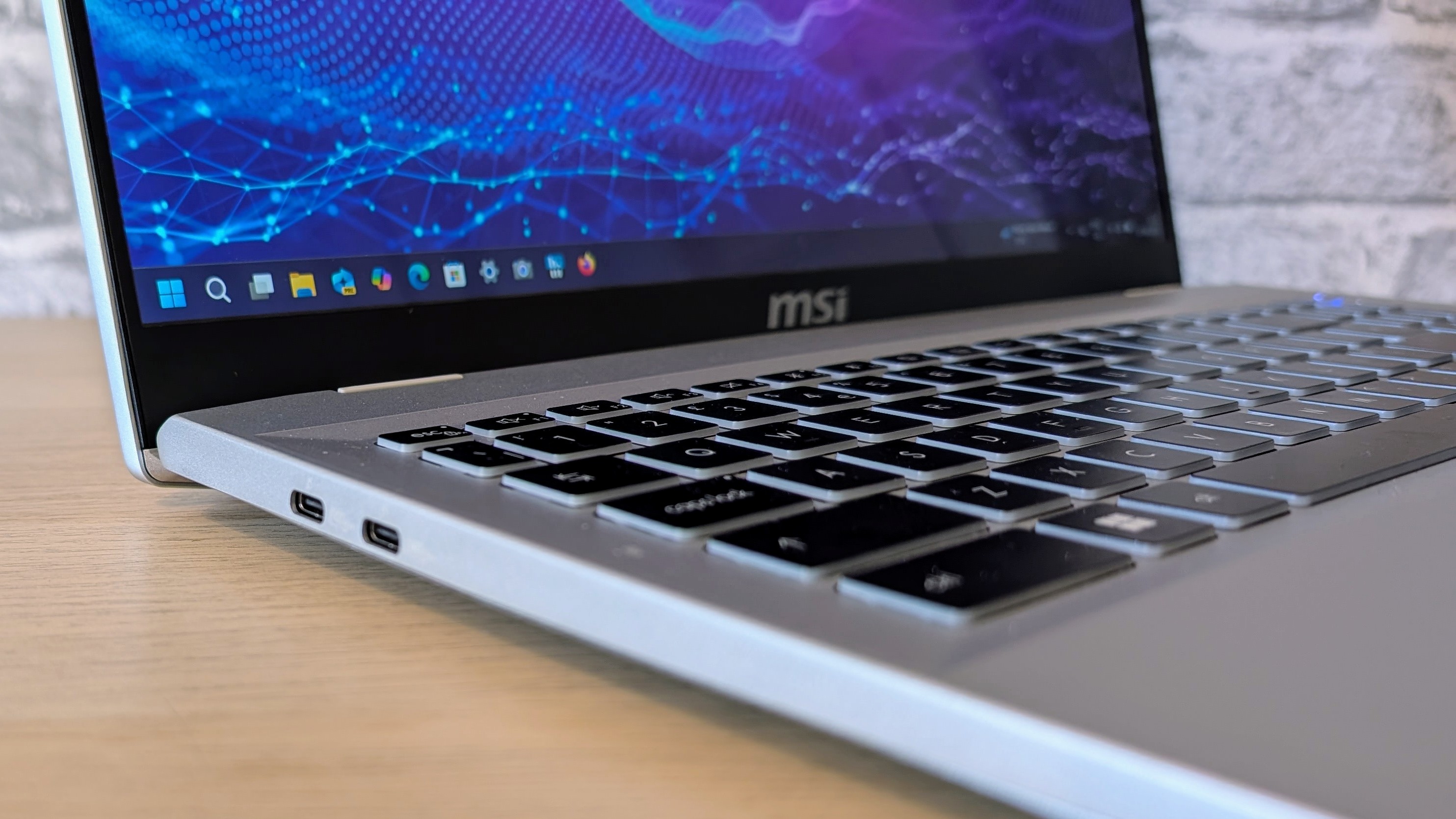The MSI Prestige A16 AI+ is one of the best business laptops on the market
Only the absence of a second SSD slot stands between MSI's latest 16-inch business laptop and true excellence

-
+
Long battery life
-
+
Bright 165Hz display
-
+
Good value
-
+
Strong performance
-
-
No space for a second SSD

MSI's Prestige lineup is the company's premier range of conventional laptops without touch screens, sitting below the 2-in-1 convertible Summit machines but above the workaday Modern series. Historically, Prestige laptops have offered a good balance between performance, style, and value typified by the likes of the 2024 Prestige 16 AI Studio.
For 2025, the 16-inch Prestige machines have been given the latest AMD Ryzen AI 300 chipsets, while the 13.3-inch models get Intel's latest Series 2 Core Ultra processors. This, of course, means they carry Microsoft's Copilot+ stamp of approval.
The 2025 Prestige A16 AI+ comes in one basic specification but with a choice of displays: 2.5K 165Hz IPS or 3.8K 60Hz OLED, and it's the former that MSI sent us for review.
One would assume that the OLED model would cost more, but while the IPS machine is generally available for £1,299 (£1,082 ex-VAT), the only UK retailer stocking the OLED model is selling it for £1,040 ex-VAT, which makes it quite the bargain.
MSI Prestige A16 AI+: Design

Physically, the new Prestige is a very business-like affair. The design is crisp and modern, though it perhaps lacks the flair of a comparably sized Apple MacBook Pro or Asus Zenbook.
An all-metal affair, the Prestige A16 feels impressively solid with very little flex in evidence in either the body or lid when you give it a hard twist. The A16 is also MIL-STD-801H resistant to various degrees of vibration, temperature change, humidity, and shock.
There's only one colourway, which MIS calls Urban Silver, which is wholly generic, but it does a very good job at keeping greasy fingerprints at bay, which in our opinion is more important than a superficially jazzy paint job.
Sign up today and you will receive a free copy of our Future Focus 2025 report - the leading guidance on AI, cybersecurity and other IT challenges as per 700+ senior executives
At 358 x 259 x 17.4mm and 1.9Kg the Prestige compares favourably with the 16-inch MacBook Pro, which is 250g heavier but a few millimetres narrower, thinner, and shallower. The Asus Zenbook S16 is slightly smaller still and a lot lighter at 1.5Kg but like the MacBook, it lacks a numeric keypad.
Looking at the ports, on the left side of the body, you'll find two Thunderbolt 4 ports, while on the other edge is an HDMI 2.1 video output, a 10Gbps USB-A port, a MicroSD card slot, and a 3.5mm combination audio jack. We'd call that a more than decent selection.
Getting inside the A16 is a simple operation once you have removed the seven Philips screws (one under a factory seal) that hold the base plate on, but we were disappointed to find there was no mount for a second SSD though there was plenty of unoccupied space for one.
The 32GB of RAM is fixed in place as we expected, given the chipset, but there is easy access to the sole SSD mount and the Qualcomm 7800 wireless card, which supports Wi-Fi 7 and Bluetooth 5.4.
The dual-fan cooling system is also easy to access should you need to defluff the fan housings, and the battery looks as though it will come out without any undue drama.
The 1TB Samsung-made SSD in our review unit proved more than quick enough for everyday use, recording good sequential read and write speeds of 4,046MB/s and 2,952MB/s, respectively.
MSI Prestige A16 AI+: Keyboard, touchpad and webcam
The essentially conventional keyboard has two layout features that we always look for here at ITPro. Firstly, there is a numeric keypad, and secondly, all four arrow keys are the same size and square.
The numeric and arrow keys are admittedly only two-thirds the size of the rest of the keys, but that's a small price to pay for squeezing them onto a pretty compact 16-inch machine in the first place. The reduced size of the keys had no impact on usability or typing speed as far as we were concerned.
The location of the second return key below rather than next to the keypad is not exactly a common feature, but proved surprisingly convenient and efficient when inputting data.
The only small peculiarity is the location of the Fn key, which on the Prestige is placed to the right of the spacebar next to the Copilot key. Presumably, this was to allow for the fitting of slightly thinner Copilot and Fn keys to accommodate the square arrow keys.
Physically, the keyboard is impressively solid with little detectable give in the deck even under heavy pressure, while the keys themselves have a smooth 1.5mm travel and a well-damped end-stop.
The graphics are models of clarity, while the three-level backlight shines clearly through the tops and translucent sidewalls of the keycaps.
The 130 x 82mm touchpad has a smooth Mylar surface and a positive, well-damped click-action that doesn't make an excessive amount of noise. Like all good touchpads, it just works without the user noticing.
MSI hasn't stinted on security with the Prestige A16, so you get a fingerprint scanner that is separate from the power button in the lower-right corner of the palmrest, as well as Windows Hello facial recognition.
The webcam array also has a manual privacy shutter and a presence sensor, which MSI calls Smart Guard, that can turn the display off if you leave your desk. The webcam itself is a 1080p, 30fps affair and does a fine job of generating bright and colorful images even in less than ideal ambient lighting. The video feed was, however, just a little on the noisy side for a FullHD camera.
The AMD NPU bestows full Copilot status on the Prestige A16, so you get all the latest Windows 11 AI bells and whistles, including Recall, Studio Effect, Live Captions, and Paint Cocreator.
MSI Prestige A16 AI+: Display

For a general-purpose productivity laptop, the MSI has a very high-quality display. The 2,560 x 1,600 non-touch, gloss finish IPS panel has an impressive maximum brightness level of 470cd/m2 and is very colourful with gamut volumes of 137.5% sRGB, 97.4% DCI-P3 and 94.7% AdobeRGB.
MSI doesn't offer any pre-installed color profiles, and there's no facility to swap profiles within the MSI Centre S control panel, but given that the screen recorded a perfectly good Delta E variance of just 1.8 against the AdobeRGB profile, we don't see that as an issue.
The display's final treat is its 165Hz refresh rate, which makes on-screen animations like scrolling through spreadsheets just that little bit smoother than you'll see on a standard 60Hz panel.
MSI Prestige A16 AI+: Specs and performance
The new MSI is built around the AMD Ryzen AI 9 365 CPU, a 10-core, 20-thread chip with a 34MB cache and a maximum turbo frequency of 5.0GHz. Along with that, you also get a 50 TOPS NPU, AMD's potent AMD Radeon 880M integrated GPU with 32GB of LPDDR5x-7500 RAM.
The Prestige performed well in our in-house 4K multi-media benchmark, scoring 437 points, some 40 points ahead of both the M4 MacBook Pro and Asus Zenbook S16, the latter running on the nominally more powerful AMD Ryzen AI 9 HX370 CPU.
The Cinebench R23 benchmark also showed the Prestige in a good light, the 18,271 multi-core score again beating both the M4 MacBook Pro and the Zenbook S16.
Turning to graphics performance, the Prestige A16 ran the SPECviewperf 3dsmax 3D modelling benchmark at a very impressive 33fps, an excellent score for an integrated GPU if not quite on a par with its big brother, the Radeon 890M, found in the Zenbook S16.
The dual-fan cooling system inside the Prestige isn't the quietest we've encountered, but it is very effective at getting rid of hot air, allowing both the CPU and GPU to run at 100% utilisation for prolonged periods under maximum stress
Given that the Prestige has an 82Wh battery, we expected a good showing when it came to battery life, and so it proved, the lights staying on for 17 hours and 2 minutes in our standard video rundown test using the VLC media player.
That's on a par with a 16-inch MacBook and 90 minutes better than a Zenbook S16, which admittedly has a smaller 78WHr battery and a higher-resolution OLED display.

MSI Prestige A16 AI+: Is it worth it?
For its price, the Prestige A16 AI+ represents very good value, delivering a well-made package with impressive performance, long battery life, a comprehensive keyboard and a bright, colourful IPS display.
Given that MSI seems to have been so careful to tick all the boxes that a demanding business user wants to see ticked, it's surprising that it didn't feel the need to fit a second SSD mount or to install a rather better sound system.
Of course, unless you plan on storing masses of data on your laptop or using it to listen to Wagner, both those failings may pass you by unmarked.
At the time of writing, the OLED model is slightly cheaper than the IPS version, so that's probably the one to go for, though the 3.8K OLED panel is likely to hurt battery life. That said, either model is likely to satisfy even the most demanding business user.
MSI Prestige A16 AI+ A3HM: Specifications
Processor | AMD Ryzen AI 9 365 | Row 0 - Cell 2 |
RAM | 32GB LPDDR5X-7500 | Row 1 - Cell 2 |
Graphics | AMD Radeon 880M | Row 2 - Cell 2 |
Storage | 1TB M.2 2280 SSD | Row 3 - Cell 2 |
Screen | 16in, 2,560 x 1,600, IPS, 165Hz | Row 4 - Cell 2 |
Memory card slot | Yes, MicroSD | Row 5 - Cell 2 |
Graphics outputs | Thunderbolt 4 x 2, HDMI 2.1 | Row 6 - Cell 2 |
Other ports | USB-C x 2, USB-A 3.2 Gen 2 x 1 | Row 7 - Cell 2 |
Biometrics | Fingerprint scanner, facial recognition | Row 8 - Cell 2 |
Operating System | Windows 11 Pro | Row 9 - Cell 2 |
Connectivity | Wi-Fi 7, Bluetoothv5.4 | Row 10 - Cell 2 |
Dimensions (WDH) | 358 x 259 x 17.4mm | Row 11 - Cell 2 |
Weight | 1.9Kg | Row 12 - Cell 2 |
Battery capacity | 82Wh | Row 13 - Cell 2 |
Over the years, Alun has written freelance for several online publications on subjects ranging from mobile phones to digital audio equipment and PCs and from electric cars to industrial heritage. Before becoming a technology writer, he worked at Sony Music for 15 years. Quite what either occupation has to do with the degree in Early Medieval History he read at the University of Leeds is a bit of a grey area. A native of Scotland but an adopted Mancunian, Alun divides his time between writing, listening to live music, dreaming of the glens and dealing with an unhinged Norwegian Elkhound. For ITPro, Alun reviews laptops and PCs from brands such as Acer, Asus, Lenovo, Dell and HP.
-
 Trump's AI executive order could leave US in a 'regulatory vacuum'
Trump's AI executive order could leave US in a 'regulatory vacuum'News Citing a "patchwork of 50 different regulatory regimes" and "ideological bias", President Trump wants rules to be set at a federal level
By Emma Woollacott Published
-
 Microsoft Excel is still alive and kicking at 40 – and it's surging in popularity as 82% of finance professionals report ‘emotional attachment’ to the spreadsheet software
Microsoft Excel is still alive and kicking at 40 – and it's surging in popularity as 82% of finance professionals report ‘emotional attachment’ to the spreadsheet softwareNews A recent survey found Gen Z and Millennial finance professionals have a strong “emotional attachment” to Microsoft Excel
By Emma Woollacott Published
-
 LastPass hit with ICO fine after 2022 data breach exposed 1.6 million users – here’s how the incident unfolded
LastPass hit with ICO fine after 2022 data breach exposed 1.6 million users – here’s how the incident unfoldedNews The impact of the LastPass breach was felt by customers as late as December 2024
By Emma Woollacott Published
